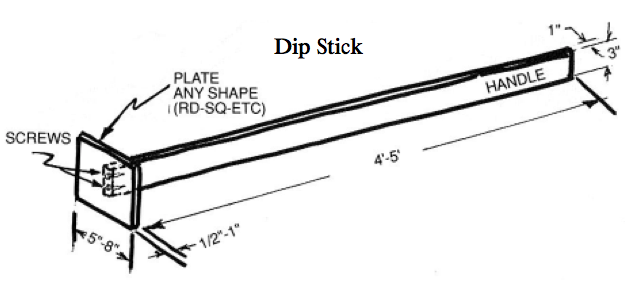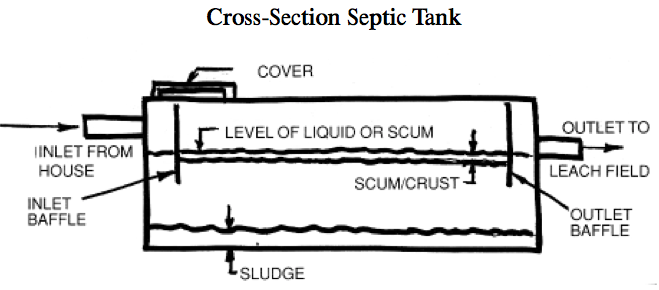Septic tanks should be checked at least once every five years. The homeowner can easily do this; the simple procedure is outlined below. A septic tank should never be entered by the homeowner. Poison- ous gases are present., and individuals who have entered septic tanks have died from gas asphyxiation.
1. Remove the septic tank cover. The cover of the tank will be at the end nearest the house. If the location of the tank is unknown, check the direction of the large wastewater pipe coming from the toilet. The tank is usually in that direction, about 10 feet from the house. On most waterfront lots the top is less than a foot below the surface of the ground; many are at ground level or above.
The typical steel tank is shaped like a flattened oval. The cover is held in place by several tabs that must be bent back before removal. Fiberglass tank covers may be bolted in place. Concrete tanks usually have a metal lifting handle on the access cover.
2. Preparing a dipstick. A dipstick is required to check the sludge depth. An effective stick can be made by fastening a flat piece of wood about six inches wide to the end of a long stick. The purpose of the flat piece of wood (plate) is to get a “feel” for the sludge. A plain straight stick will easily push through the sludge and make evaluation of the depth difficult.
3. Evaluation of Tank Contents. After the cover is removed, note the level of the liquid in the tank. It is normal to have a scum or crust on top of the liquid. Sometimes this will be over an inch thick and appear almost solid. The level of the liquid or crust should be below the inlet baffle. If it is above the inlet baffle, there is a problem with the outlet of the tank or leach field. If the level of the liquid is very low (more than four inches below the inlet pipe) there may be a leak in the tank. If you find either of these situations, have the system checked by a service contractor.
4. Sludge Evaluation. After breaking through the crust, if there is one, slowly push the plate end of the stick down toward the bottom. Keep the stick nearly vertical. When the plate reaches the top of the sludge, a resistance will be felt. Put a mark on the stick at the top of the tank or note the approximate depth of the stick. Then, push the stick down through the sludge until the plate hits the bottom of the tank. That extra distance is the sludge depth.
Normal sludge depth is one to four inches. If greater, or if less than 10 inches of water above the top of the sludge exists, check with a service contractor about a pump out.
If there is a solid, thick (over one inch) crust on the top, it should be pumped out with the rest of the tank contents. Thick crusts may be the result of excessive soap, grease or fats put down the drain.
5. Baffle Evaluation. The condition of the baffles should be checked to be sure they are in place and not rusted out. The baffles can be checked by sliding the plate end of the stick down the edge of the inlet baffle. The lower end of the baffle is well above the bottom of the tank. On most tanks, angling the dipstick toward the far end of the tank can also check the outlet baffle.
6. Replace the cover and bend the tabs back to secure it in place.
7. CAUTION: When experiencing a septic tank problem, property owners frequently assume that the tank needs to be pumped. This may not be the case. If there is a problem with toilet operation or the septic tank overflows or smells, the real problem may be a clogged line to the septic tank or a plugged leach field. You should be very sure that your tank is overloaded with sludge and/or scum and really needs to be pumped. In fact, seasonal-use tanks seldom need to be pumped.
In collaboration with:
Eric E. Murdock, P.E.




